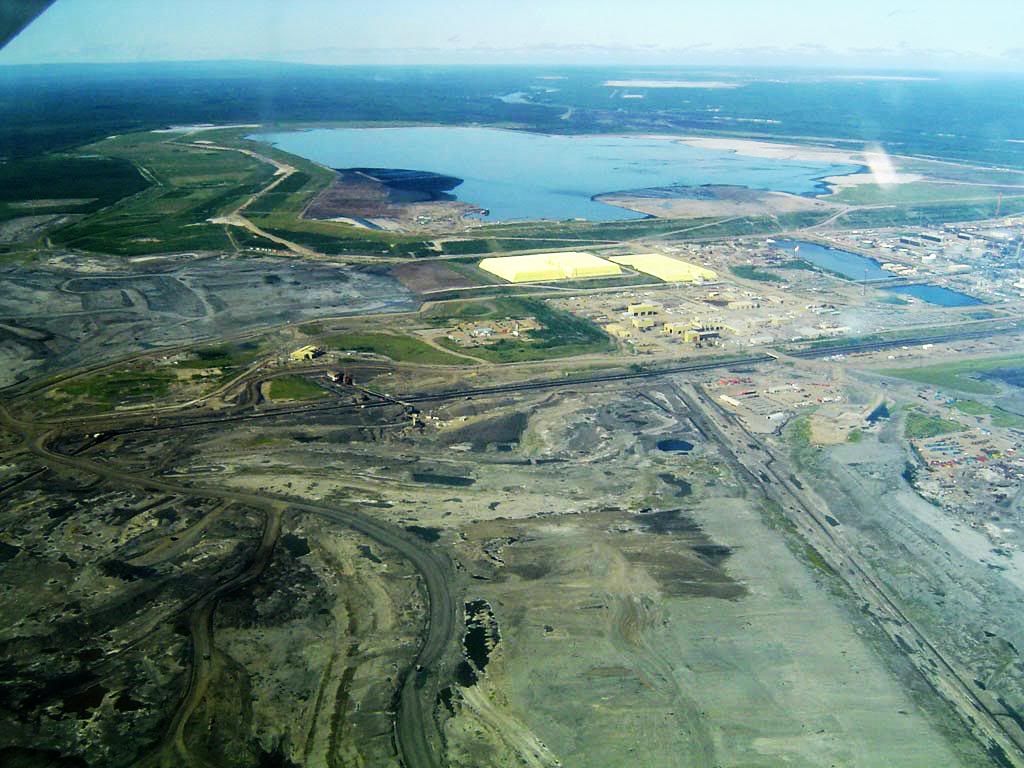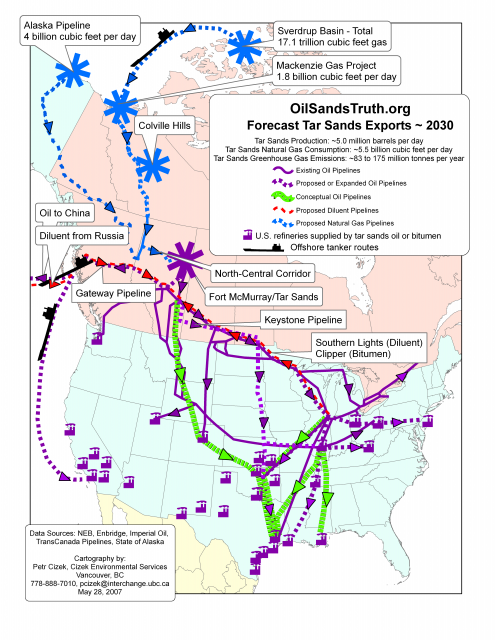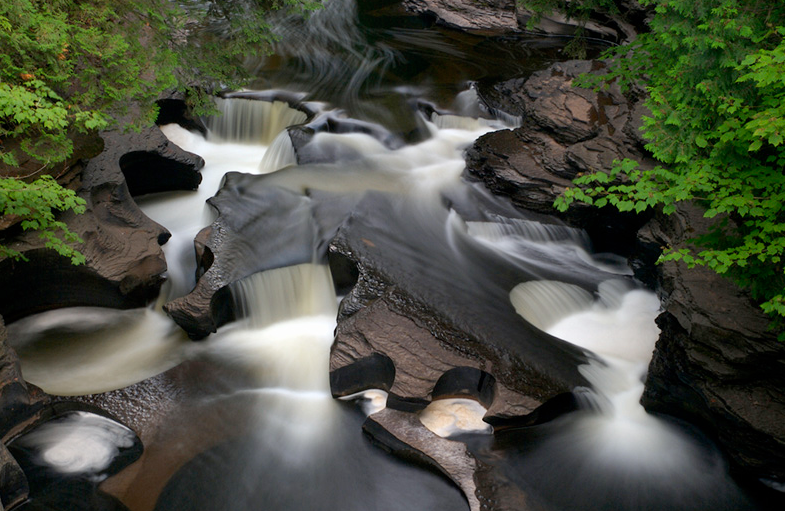
The production of crude oil from Canada's tar sands is arguably the dirtiest business in the world. While most people have heard of Canada's tar sands, what I hope to accomplish with this diary is to explain some of the lesser-known aspects of producing crude oil from bitumen. I will address how massive inputs of natural gas and water are required to extract bitumen and explain why even more natural gas is then needed to synthesize crude oil that can be transported via pipeline from the Canadian tar sands to refineries in the United States. I would then like to address several historical facts, current environmental realities, and political challenges associated with the present policy of laissez-faire economic development of the Canadian tar sands embraced by Stephen Harper's minority government.
First, a little on my background. I am an expat American who studied geography in Montreal and am currently pursuing a masters degree in environmental impact assessment. You can find some of my research interests and writing over at my website, Earth Alternatives. There are also some good links to blogs, non-governmental organizations, and government agencies that are useful resources if you are interested in environmental issues.
I have wanted to write on this subject for a while now, and it looks like my timing is good. Just yesterday, Greenpeace released an important report on the continuing exploitation of Canada's tar sands entitled Dirty Oil: How the Tar Sands are Fueling the Global Climate Crisis. It is a useful, instructive, and well-referenced document (important in this day and age), and highly worth checking out if you have not yet read about the extremely destructive practice of extracting crude oil from bitumen. It is a 56 page document, and you can read and download the PDF in its entirety here. Another excellent resource for information about the tar sands (and some spectacular photography by Edward Burtynsky of Manufactured Landscapes fame) is the Globe and Mail's seven-part article series Shifting Sands. It is one of the finer pieces of environmental journalism written in the past few years.
Bitumen is extracted from the ground in two major ways, although others are under development. The first, more conventional way, is through surface mining. You can read more about it here. To say that it is a massive undertaking would be something of an understatement. After this surface mining takes place, it is necessary to separate the bitumen from the sand. The process is extremely water and energy intensive.
The other major method used is referred to as steam-assisted gravity drainage. Using this method, steam is injected into the ground directly above bitumen deposits and the viscous bitumen is then pumped from the bottom of the deposit. More on that one here.
By now it is probably apparent that it takes massive inputs of water and energy to separate the bitumen "tar" from the sand. That is my main point for now. More on that later.
Let's look at a little history, and then we'll get to some straight talk about Sarah Palin.
The oil crisis of the 1970s accelerated the push for what are referred to in the industry as "unconventional" sources of oil. Tar sands fall into this category. It is significantly more expensive to extract and exploit unconventional sources of oil than conventional sources of oil, so the incentive to exploit them is greatest when oil prices are high. This was the case during the early 1970s, and that is when production of oil in the tar sands began.
In early 1974, the government of Canada commissioned the Mackenzie Valley Pipeline Inquiry, commonly referred to as the Berger Commission. It set the gold standard for the way environmental impact assessments are conducted in Canada and worldwide. After three years examining the environmental, economic, and social impacts of the proposed project, the Berger Commission recommended that a ten-year moratorium be placed on natural gas development in the Mackenzie Valley in order to resolve indigenous land claims and conservation concerns.
Have a look now at this map:

Remember how one of Sarah Palin's most prized accomplishments as governor was signing a deal with a Canadian company to build a pipeline that would transport an estimated 35 trillion cubic feet of natural gas south from Alaska's North Slope? Now you can see where most of it will be going.
The striped blue lines are natural gas pipelines that will lead into the tar sands from Alaska's North Slope and Canada's Mackenzie River Delta twenty years from now. Note that no natural gas pipelines lead out of the tar sands. This is not coincidental.
Both the North Slope and the Mackenzie River Delta are now open to exploitation of natural gas reserves, largely to fuel the energy-intensive process of extracting bitumen from sand and transforming the raw bitumen into crude oil.
Once raw bitumen is recovered, it is necessary to "upgrade" it to create synthetic crude oil. Simply put, bitumen is a very low grade hydrocarbon. It has a high proportion of carbon atoms to hydrogen atoms. It is therefore necessary to "add" hydrogen atoms through various chemical processes to the extracted bitumen in order to make it a viable fuel stock that can be transported to refineries. The source for this extra hydrogen is... you guessed it, natural gas (CH4).
So the natural gas will either be burned to create steam or used to upgrade the dirty bitumen crude. Fossil fuels are therefore being used to manufacture more fossil fuels.
The tar sands are so energy intensive that the construction of nuclear reactors has been proposed:
In 2007, the Canadian Parliament reported that it would take 20 nuclear reactors to replace natural gas consumption and meet forecast oil production by 2015. The Canadian Energy Research Institute (CERI), a Calgary think-tank, envisions as many as 25 nuclear reactors providing steam and electricity for bitumen production by 2025. Several companies, including French nuclear giant Areva, have expressed interest in building several nuclear reactors near tar sands projects. To produce 200,000 barrels a day from a steam plant, Total S.A. estimates it would need 3,300 metric tonnes of steam per hour, or the equivalent of a 2,600-megawatts power plant. A typical nuclear power plant produces 3,000 megawatts... Canada could well become the first country in the world to use nuclear power to accelerate the exploitation of fossil fuels. (Nikiforik, 2009, p.22).
Today the producer cost hovers around $24 a barrel. The Canadian government and Alberta's provincial government will bring in an estimated $123 billion in corporate tax revenue from 2000 to 2020 as a result of tar sands production. (Timilsina et al., 2005, cited in Nikiforik, 2009.) Conservative Prime Minister Stephen Harper has already stated that Canada will not meet its obligations under the Kyoto Accord and has tried to shift responsibility for the problem to his predecessors in the Liberal Party, even though he has allowed tar sands expansion to continue unimpeded.
In the absence of a strong international regulatory regime with real economic incentives and penalties for both national governments and transnational corporations, Canada's tar sands will remain the dirtiest place to do business on the planet.
GreenRoots is a new environmental series created by Meteor Blades and Patriot Daily for Daily Kos. This series provides a forum for educating, brainstorming, discussing and taking action on various environmental topics.
Please join a variety of hosts on Sunday, Tuesday, and Thursday at 6 pm PDT. Each Wednesday is hosted by FishOutofWater.
 GreenRoots is a new environmental series created by Meteor Blades and Patriot Daily for Daily Kos. This series provides a forum for educating, brainstorming, discussing and taking action on various environmental topics.
GreenRoots is a new environmental series created by Meteor Blades and Patriot Daily for Daily Kos. This series provides a forum for educating, brainstorming, discussing and taking action on various environmental topics.